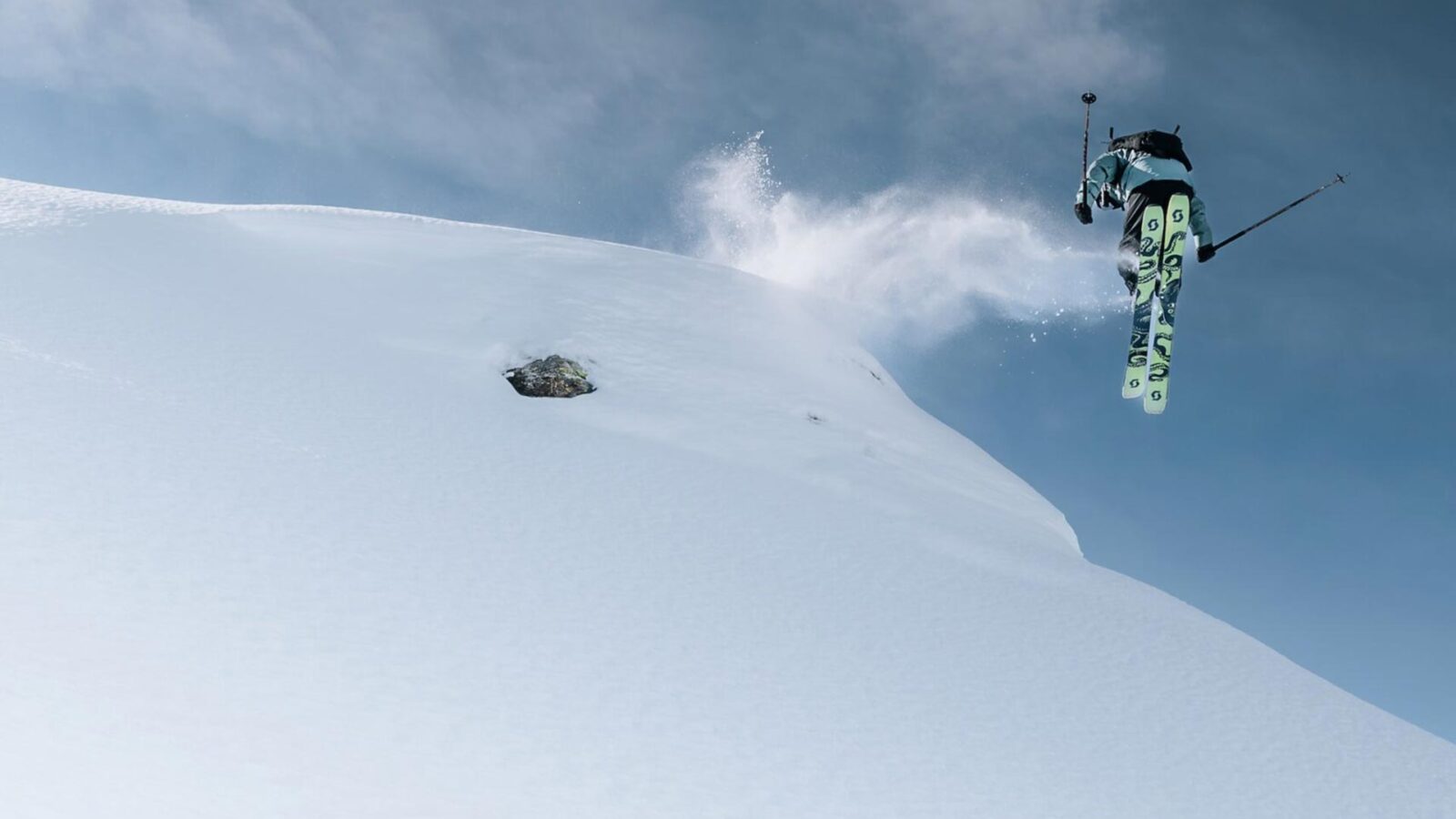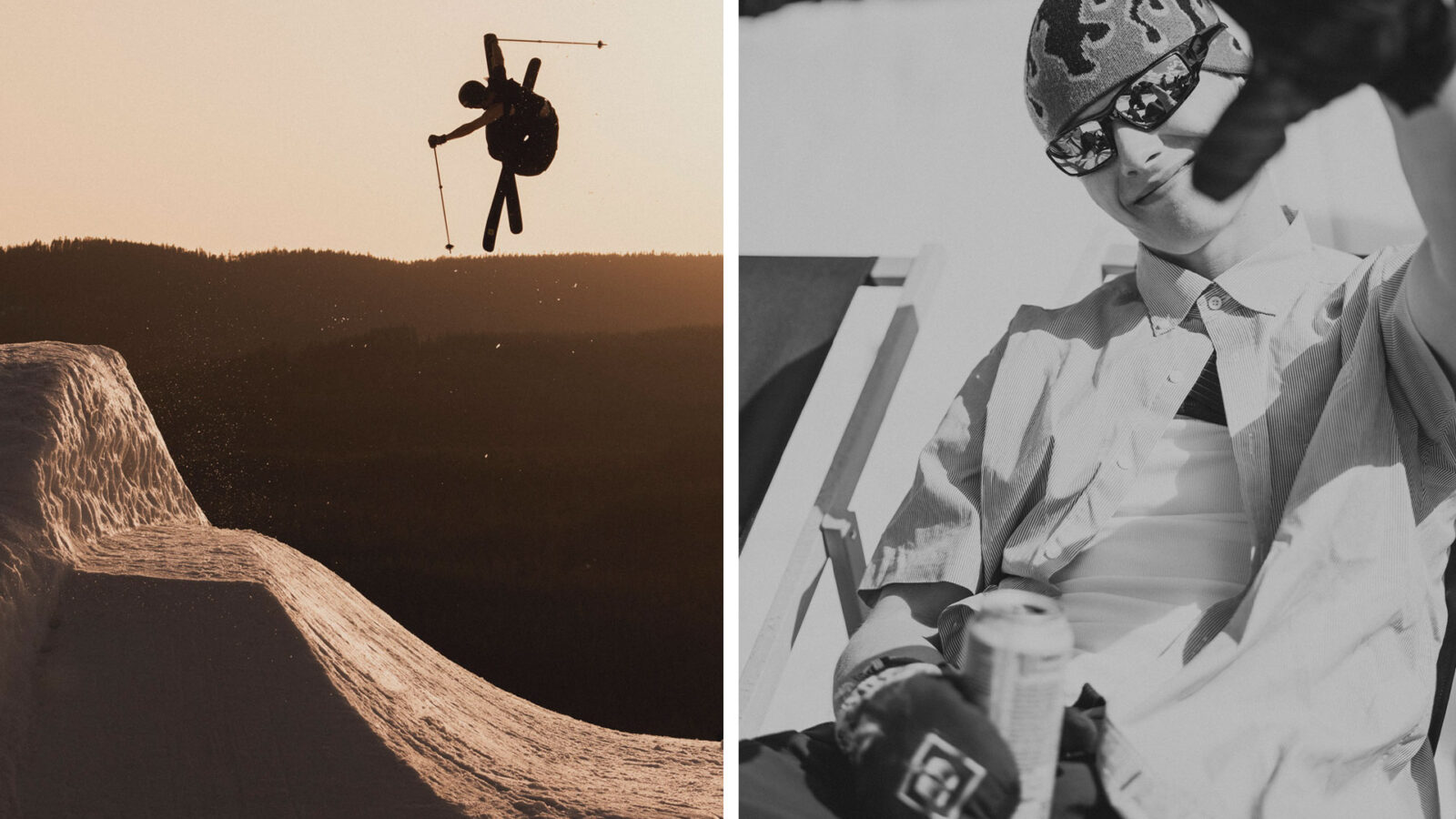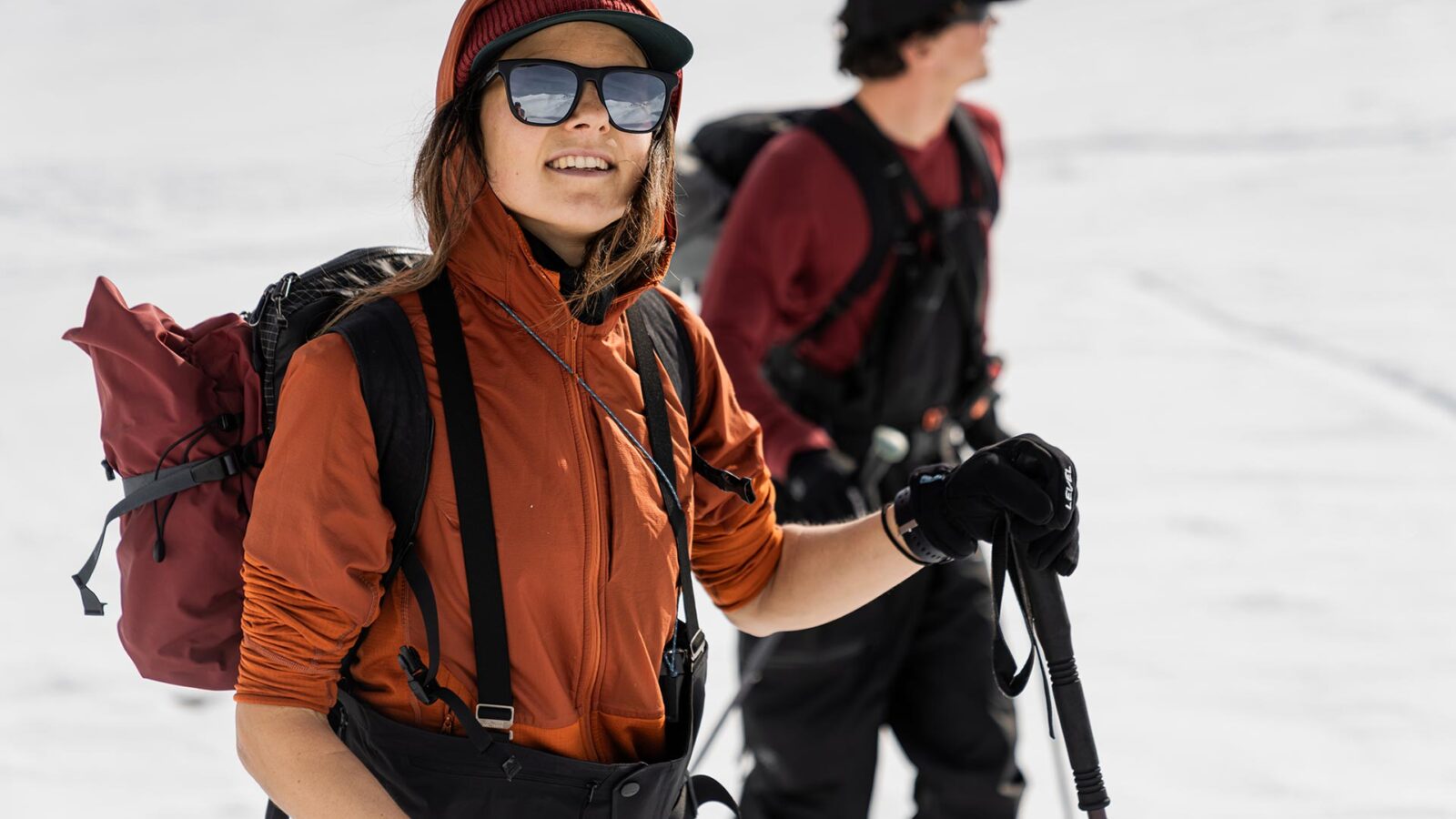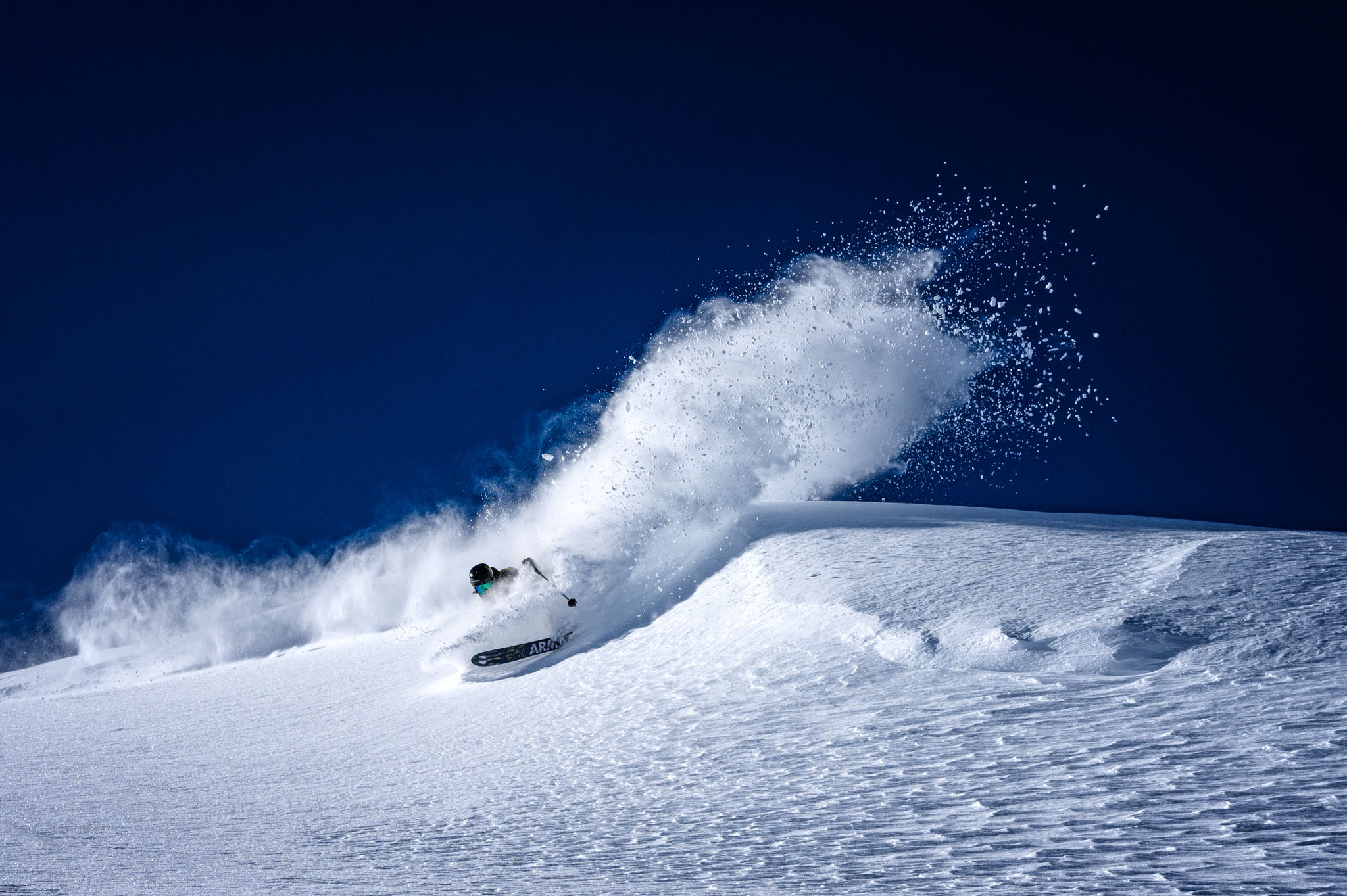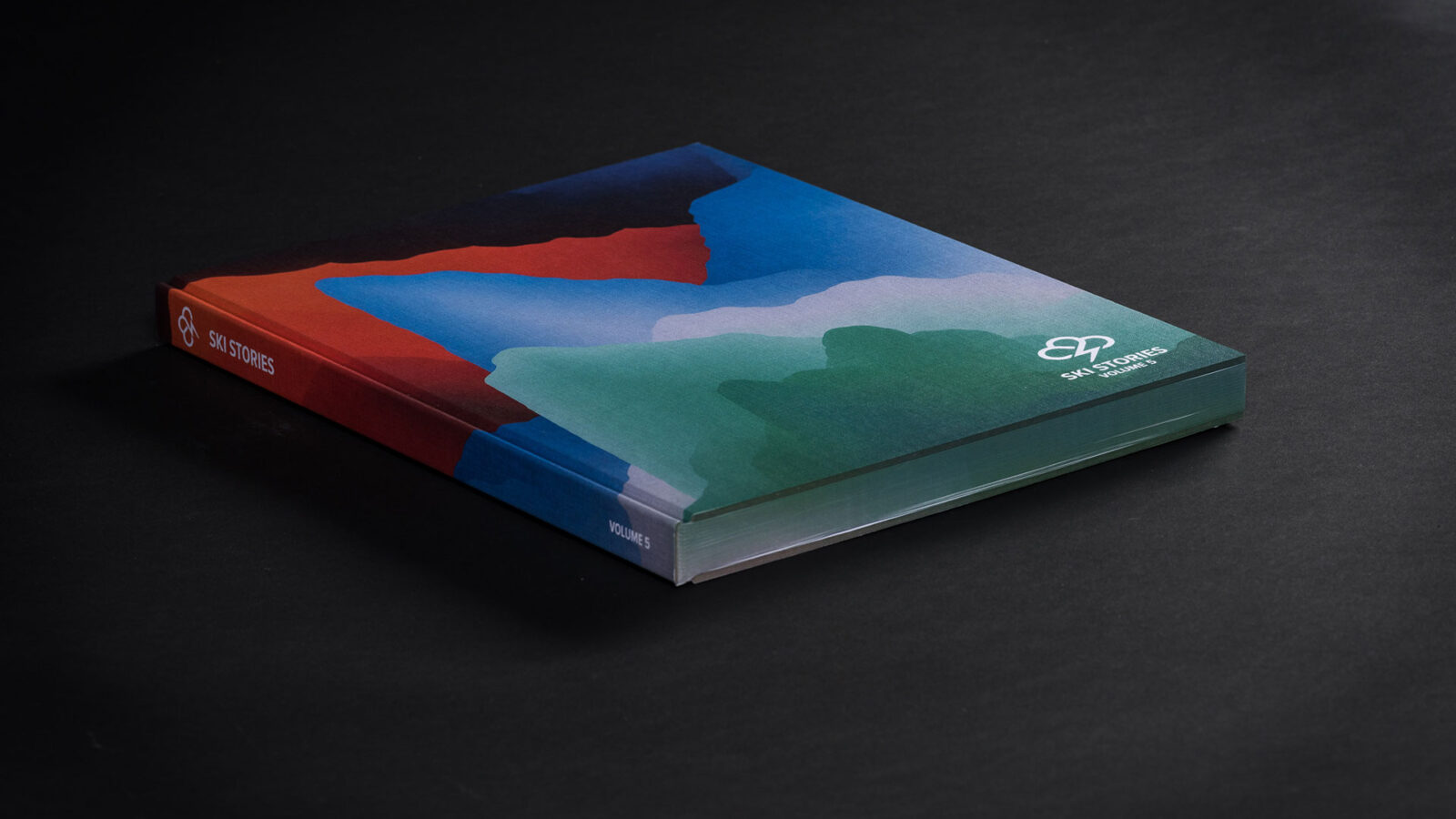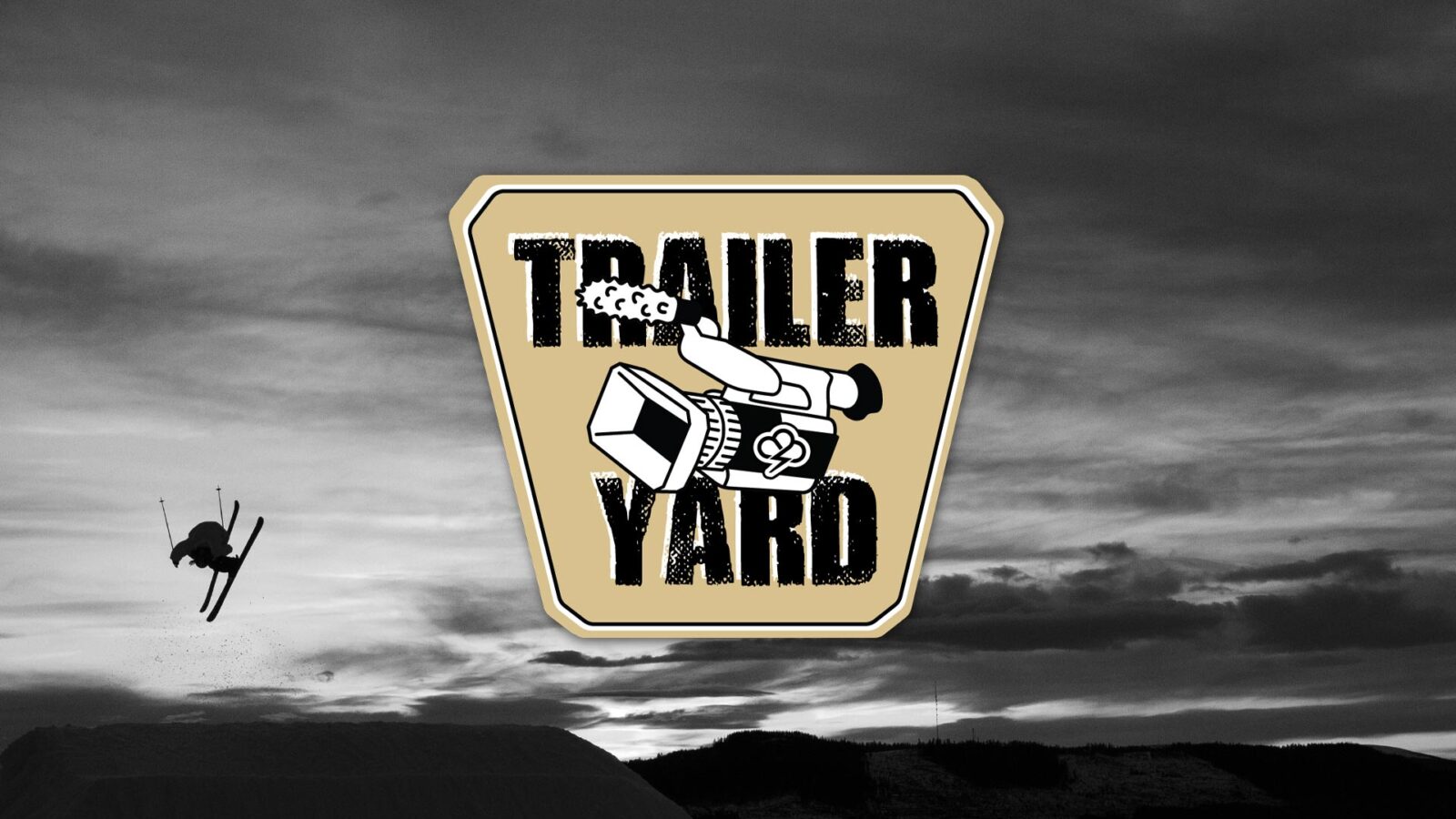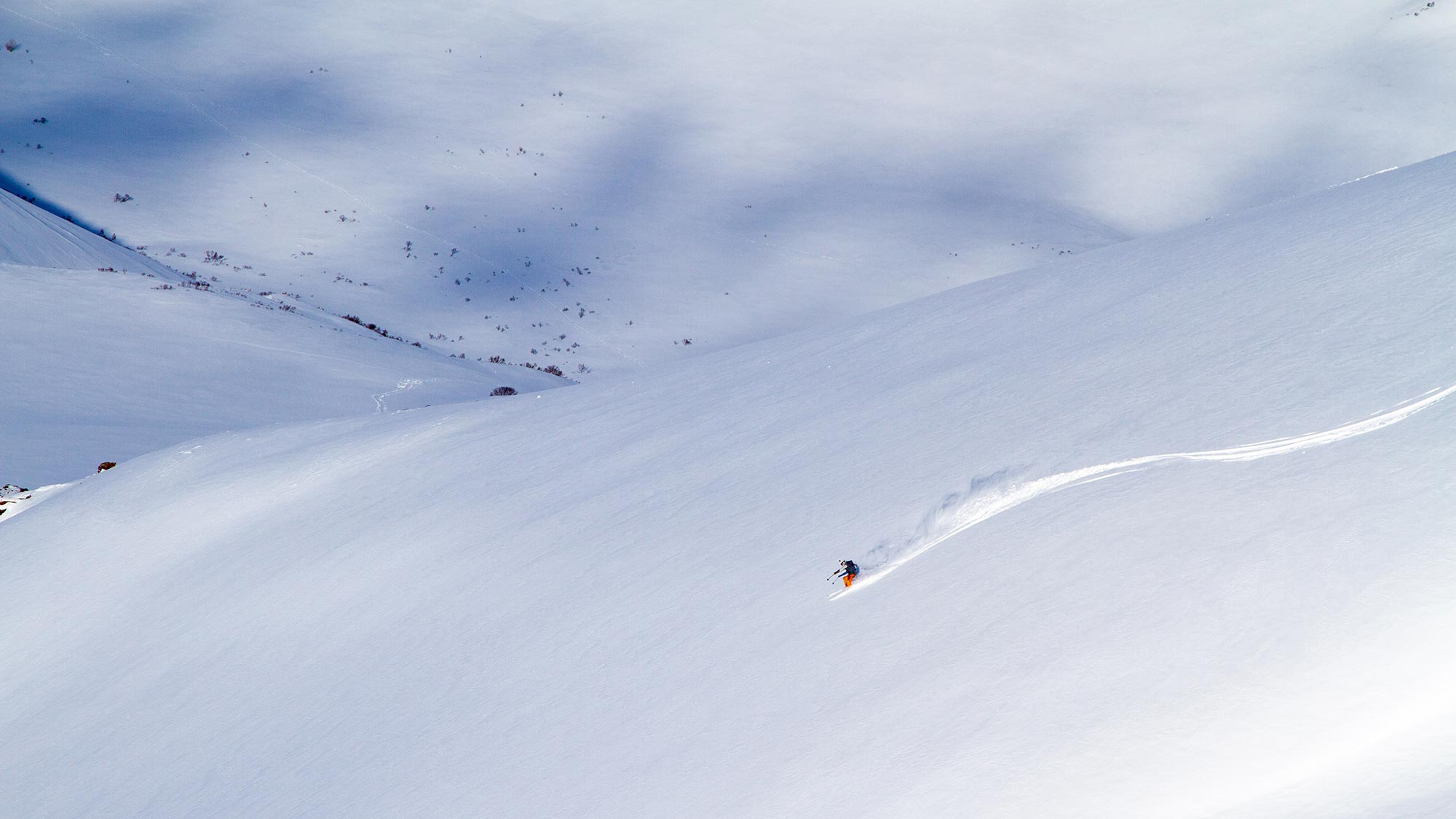
Stories
Off the Grid: Freeriding in Kamchatka | Part 1
Words: Jake Fojtik, Elliot Levey, Drew Herder
Photos: Jake Fojtik, Drew Herder
The tale of a quest for powder turns and epic lines in remote parts of Kamchatka, farther from home than any of us have been before. Thirty days beyond the ordinary: erupting volcanoes, Russian military and subzero roadside waits as supplies run low. Our goal: to climb and ski the highest active volcano in Eurasia, Klyuchevskaya Sopka. How far will the Burger Boyz go to get cultured?

Kamchatsky Chronicles // FULL FILM // PopTop Productions (Vimeo)
The Plan
Over a few Skype calls, we assembled a crew of seven crazy skiers to head to Russia, and a plan to ski once we arrived. As an initial target we selected the Gora Bakening volcano region. Nestled in an expanse of mountains called the Ganaly Range, the area offers trees, chutes, couloirs, faces and cliffs. Our second objective was the daunting Klyuchevskaya Sopka. At 4,750 meters, the peak is the highest active volcano in Eurasia, the tallest mountain in Siberia, and with 4,650 meters of vertical relief, the 13th most prominent peak in the world.
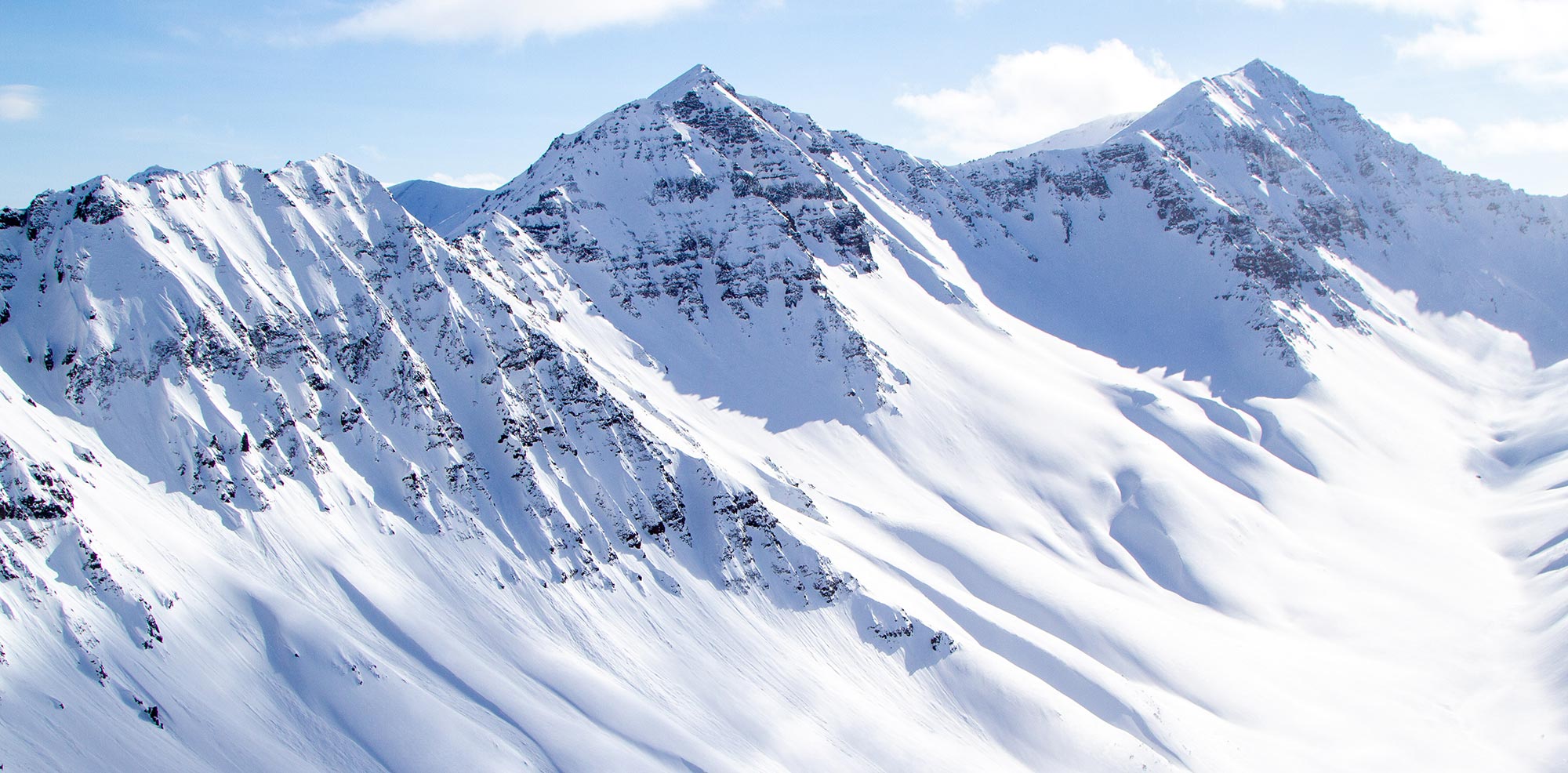
Swiss Alps or Kamchatka? A glimpse of the possibilities in the Ganaly range. Photo: Fojtik
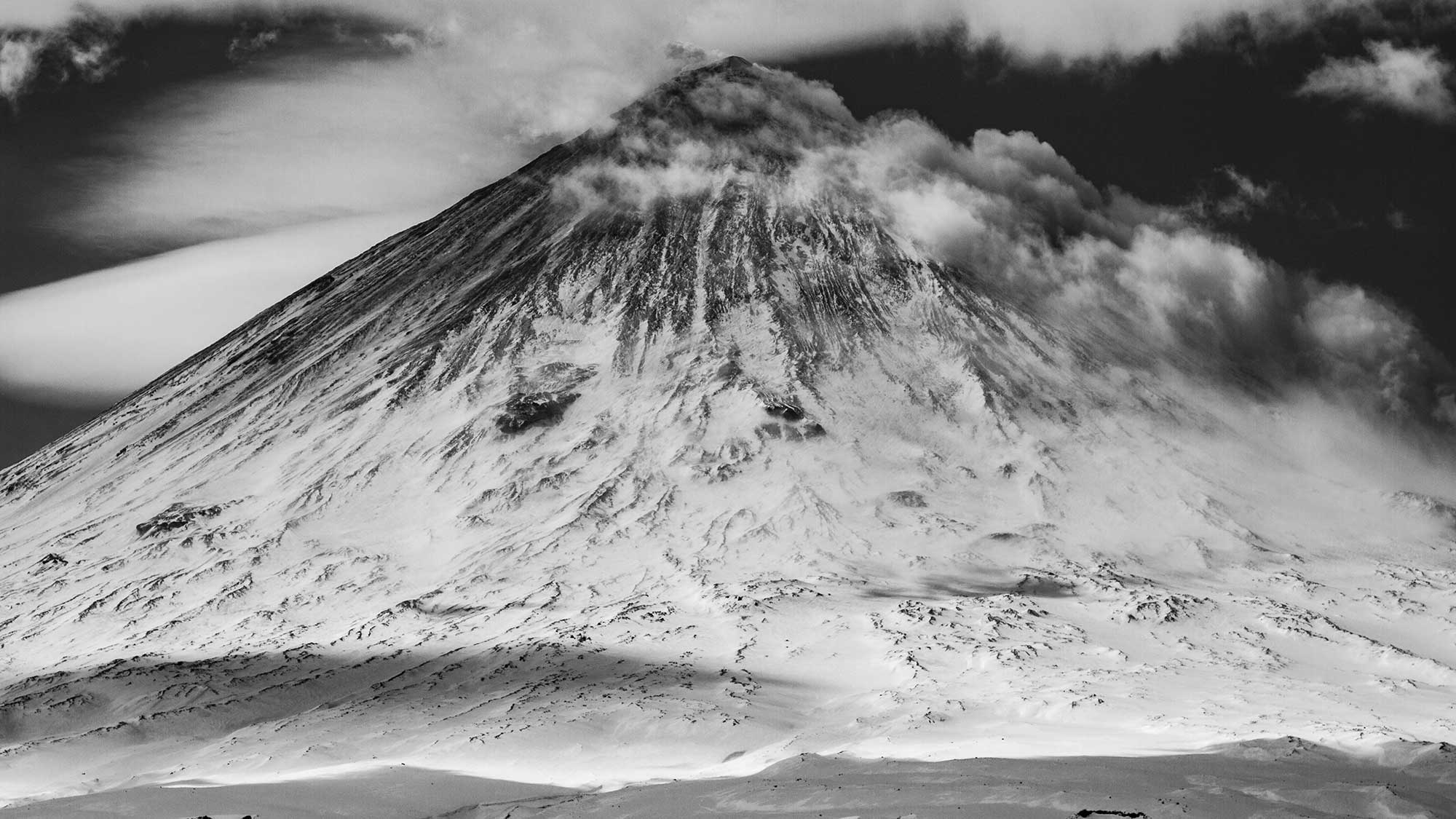
The most ambitious target of our mission, Klyuchevskaya Sopka (4,750m) towers almost comically above the surrounding plains. Photo: Fojtik
Arrival in Petropavlosk
A hectic start: Andrey, Luke and I almost missed our 5:00am flight out of Denver, barely making it in time after a sprint through the airport. On the plane from Moscow to Petropavlosk, the expanse of the Kamchatka wilderness sprawled below us: textured, snow-drenched peaks, trees, and valleys expanding into the distance.
In Petropavlovsk we met with our other expedition members: Tom, Elliot, Drew Herder and Drew Layman. They'd arrived the day before and had already acquired most of the food and fuel we'd need in the field. Elliot had gotten in a few days before anyone else and somehow, without speaking a word of Russian or knowing anyone in Petropavlovsk, had managed to rent a van, then have it confiscated on the following day.
Piles of food and gear littered our AirBnb on the top floor of a traditional Soviet-era apartment building. Our provenance for the next month: 15 kilos of pasta, five kilos of oats, 35 cans of tuna, 10 cans of chicken liver, three bags of potatoes, eight bags of gretchi, pouches of premade sauces like cream of mushroom and sweet pesto, 10 kilos of cheese, 21 servings of ramen, 10 kilos of cured sausage, eight kilos of bacon, bread, and assorted snacks to power us on long days of skiing and walking.
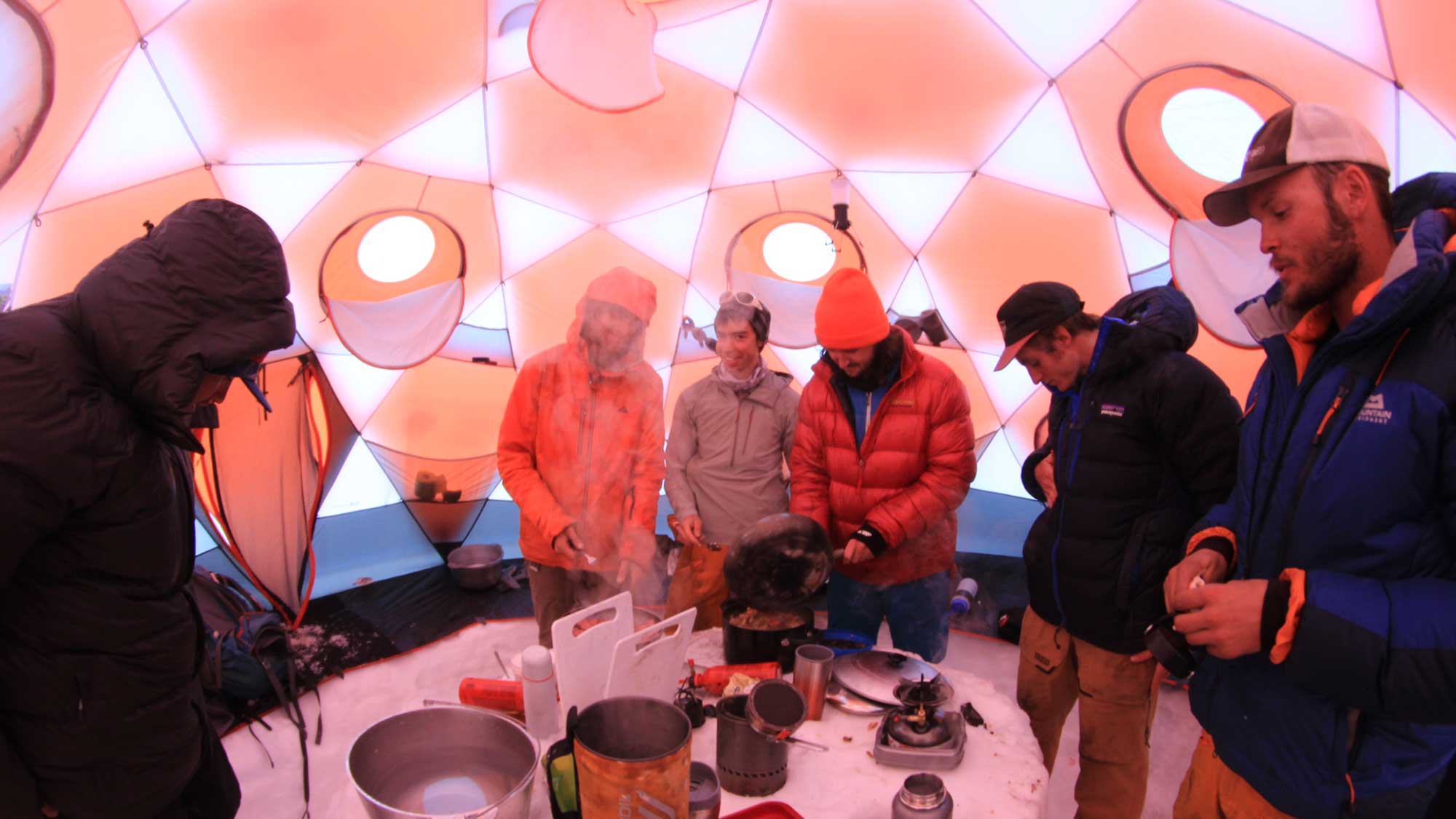
The cooking tent was a popular location at our first camp. Photo: Herder
In lieu of cleaner-burning white gas (which apparently doesn’t exist in Kamchatka), we packed 92-octane unleaded gasoline to fuel our stoves. Layman, the logistics guru, had been in contact with the Kamchatka Freeride Community, a Petropavlovsk-based heli-ski and guide company. They helped us sort our visa paperwork, provided us with transport in-country, and even refilled our avalanche airbag canisters using compressed air from a scuba tank.
The night before we set out, we stopped at Harat’s, the Irish pub in downtown Kamchatka, where one beer quickly escalated into multiple vodkas. The Petropavlovsk locals were enamored with the seven strange Americans who’d flown across the world to visit their town, and insisted on buying us drinks. At some point, many vodkas and hours later, we got thrown out of a disco and landed back at the apartment.
Bakening River Valley
After a quick pit stop to grab some last-minute food, cash, and a flashbang grenade as a bear deterrent, Alexey and Kyril of the Kamchatka Freeride Community drove us north out of Petropavlovsk the next morning. After hours on Kamchatka’s only north-south highway, which happens to be a dirt road, we pulled over to the side, unloaded the snowmobiles, and were towed into the woods.
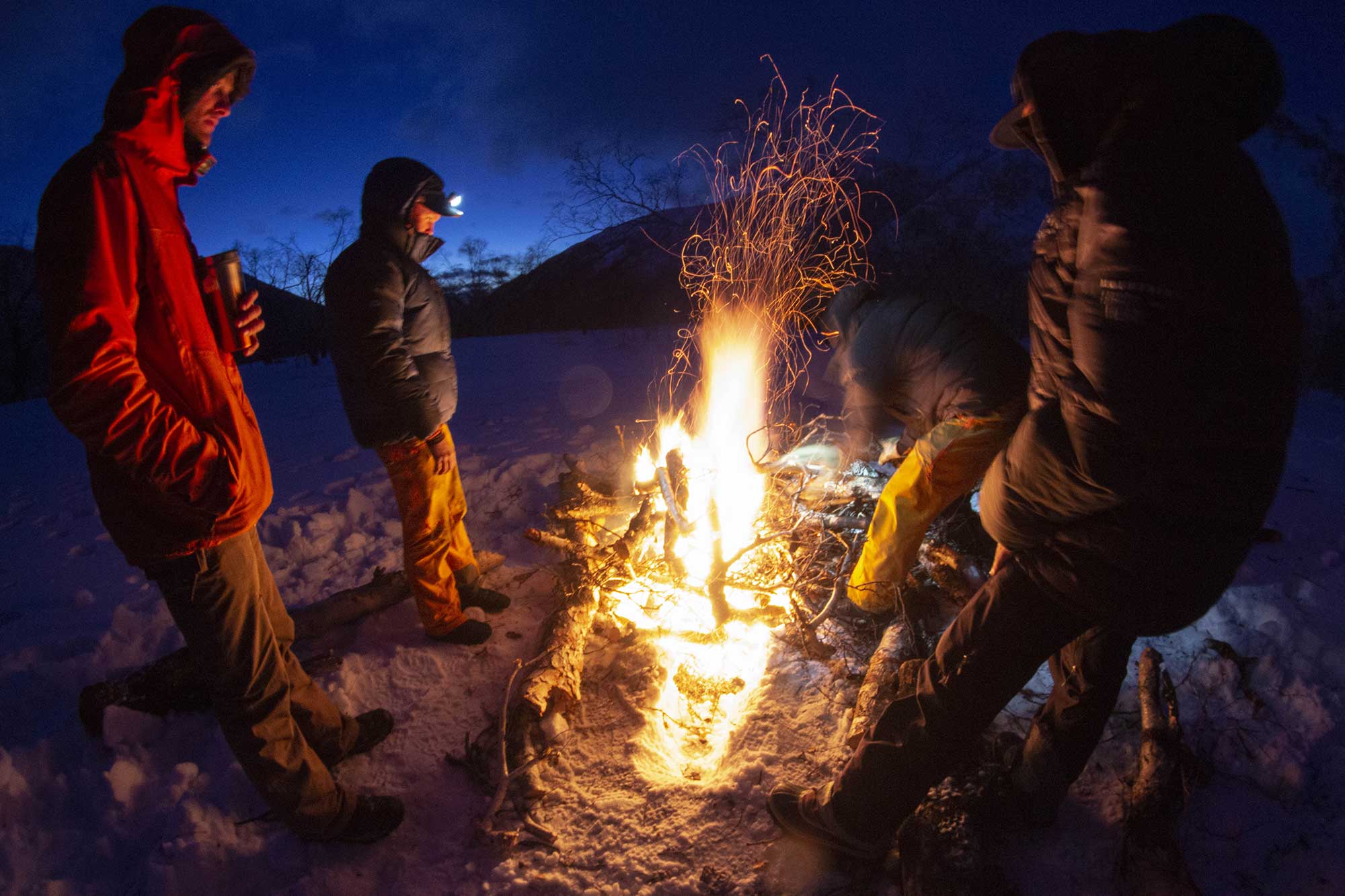
Making camp in the Ganaly range. Photo: Herder
We set up base camp just a few minutes’ skin from the Bakening volcano and began to exlore the surrounding terrain. It was better than what we’d seen in photos and on topo maps. The 2000m Bakening volcano dominated the skyline, its various gullies and couloirs on display. The adjacent valley offered dozens of faces, chutes, and couloirs on all aspects above the tree line, while lower down, closer to camp, smaller mountains covered in leafless birch trees held pockets of powder and mini-golf lines.
We poked and prodded at layers, looking for weaknesses in the snowpack, and watched the weather, clouds, sun and aspects, and how they interacted. The conditions were highly variable: cold, soft, winter snow on north-facing aspects, corn-cycle snow on lower-elevation, south-facing slopes, and residual wind slab anywhere exposed to the elements.
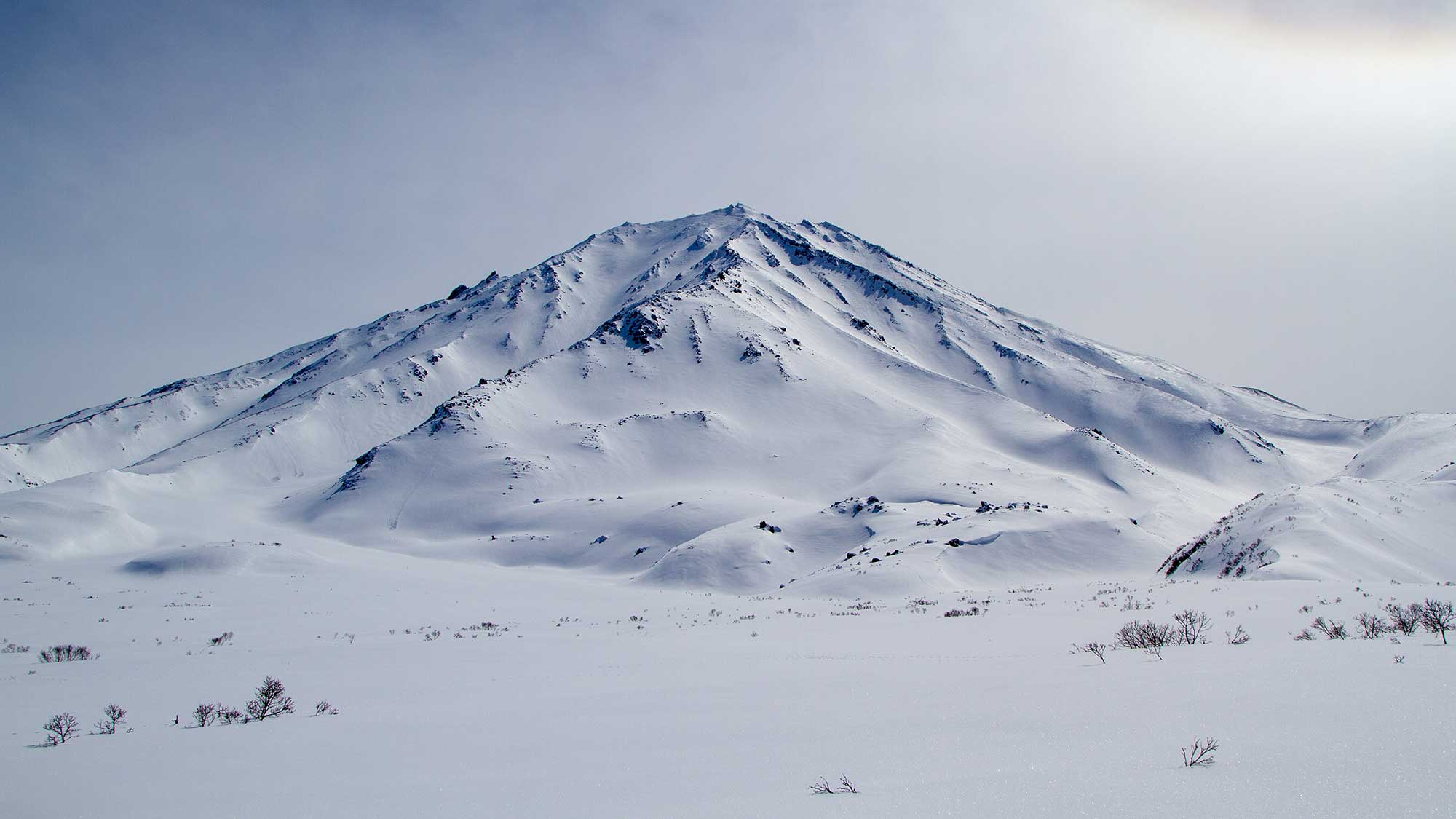
The proud Gora Bakening volcano just a few minutes´ skin from our basecamp. We climbed and skied the ridge on looker’s right. Photo: Fojtik
The Battle of Backening
Tom, Luke, Andrey and I set our sights on Bakening volcano, the crown jewel of the valley. Approaching from the south, we skinned, booted and climbed our way up a wind-scoured rib above a gully of wind-buffed powder. After a few hours of merciless hammering from the wind, we turned around less than halfway to the top, some 600 meters above the valley floor. The gully beneath offered us a nice consolation prize, with soft, stable snow for a few kilometers of continuous low-angle skiing.
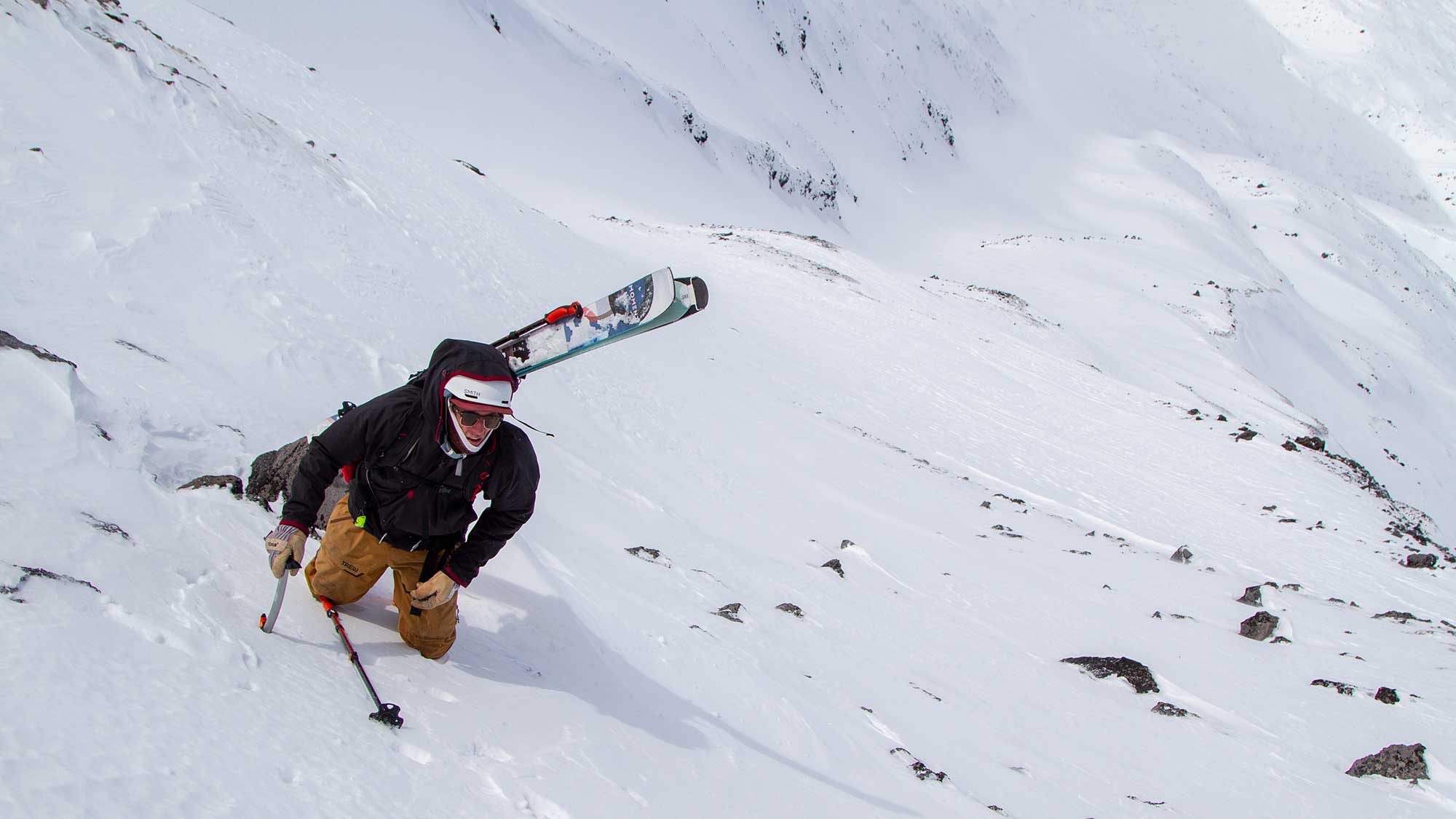
Tom preparing to drop into a gully on the north side of Gora Bakening after getting hammered by the wind for hours. Photo: Fojtik
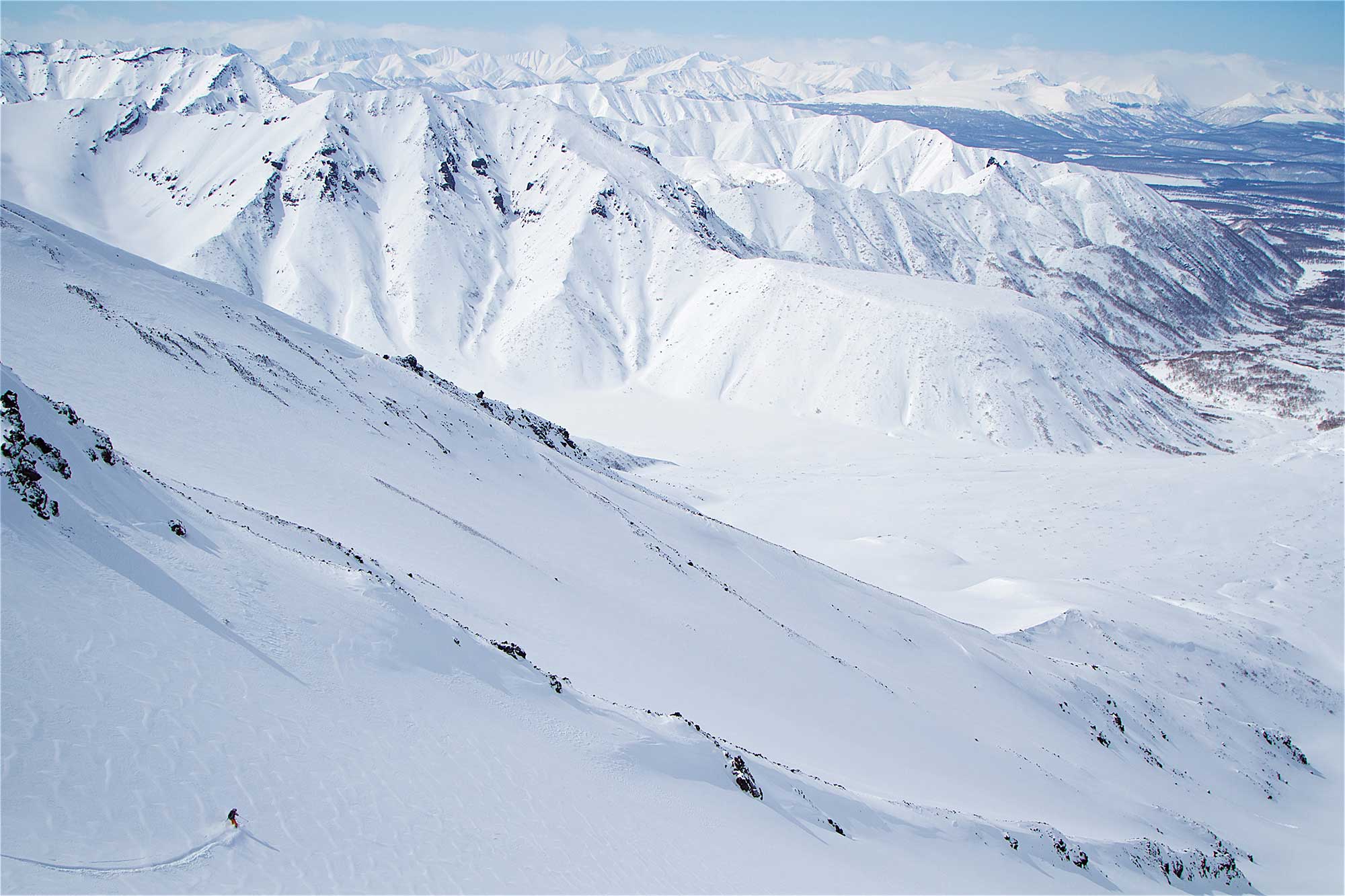
Andrey rips GS style turns down the north side of Gora Bakening. Photo: Fojtik
The next day we tried for Bakening again. This time we approached from the north, gaining a pass that separated our valley from the next one over. From the pass, we followed another rocky, windswept rib above a snow-filled gully. These gullies began as lava flows from Bakening’s peak; now, they trap and shelter windblown snow. The ridge we were on eventually dissipated into a hard, blank white face. I drove my crampons into the slope, only to find millimeters of purchase under the aluminum points. The wind ripped across the face, glazing and solidifying the slope while we fought for purchase. We traversed towards the gully, and found easier climbing in softer snow.
A few hundred meters further up, we found relief from the blistering wind beneath a cliff band less than a hundred meters from the summit. Tom and I waited under the rocks as Andrey and Luke continued to the top. It was 4:00pm, and we’d spent the last several hours beaten by the wind, inching our way up the volcano.
Andrey came down first, a hooded figure through the smoke, skis slicing through amorphous sistrugi blobs, trailed by a plume of white. Luke was next, surfing, carving, arcing clean toe-side turns, ice axe in hand. We met, high-fived, and dropped in to the 35 to 40-degree slope below, leapfrogging each other to the base of the volcano, a 1500-meter vertical descent. The snow was soft, slightly packed powder, a few inches deep, with a delicate wind board on top—enough to give the surface texture, but not catch a tip.
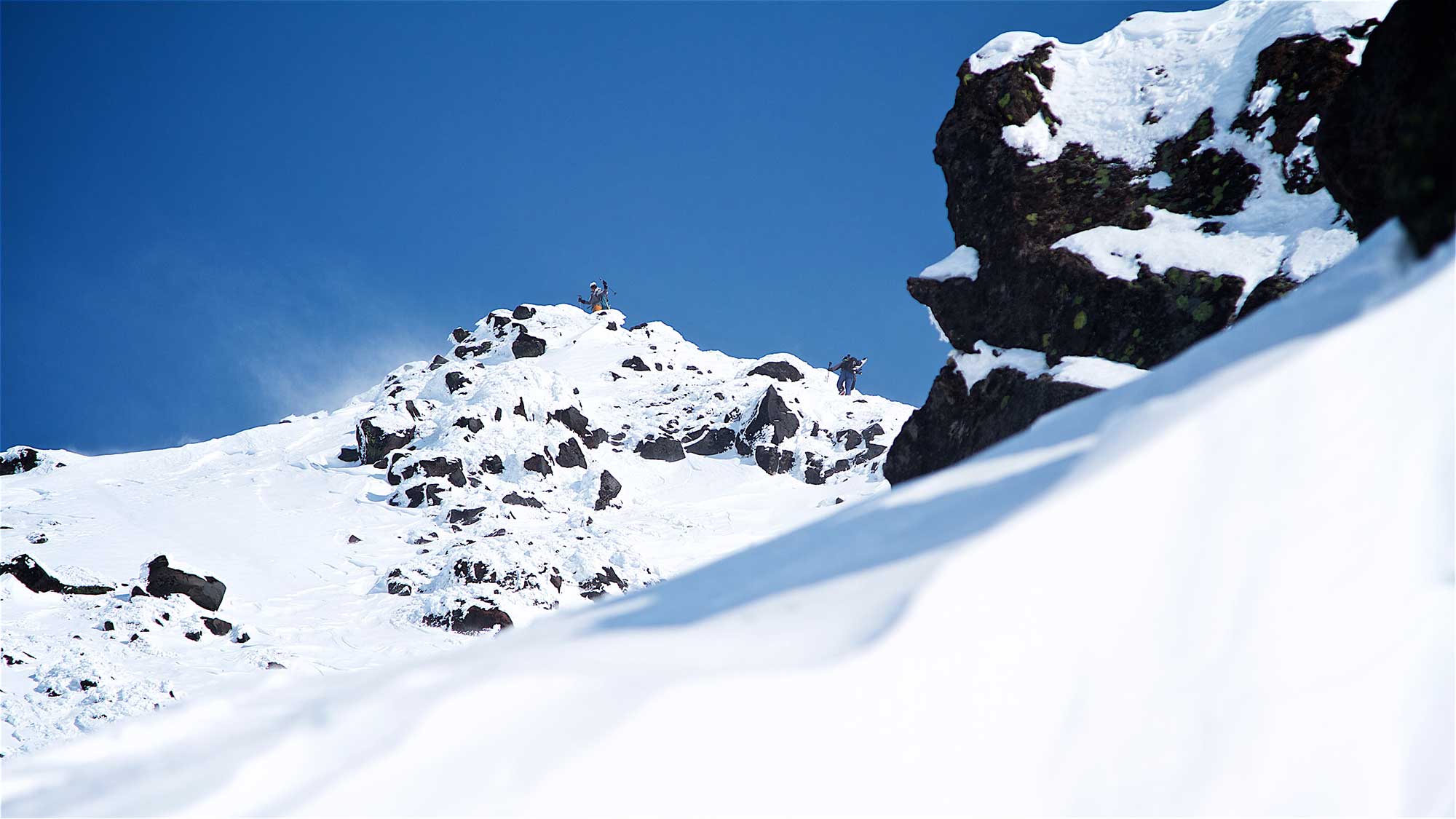
Summiting Bakening. Photo: Fojtik
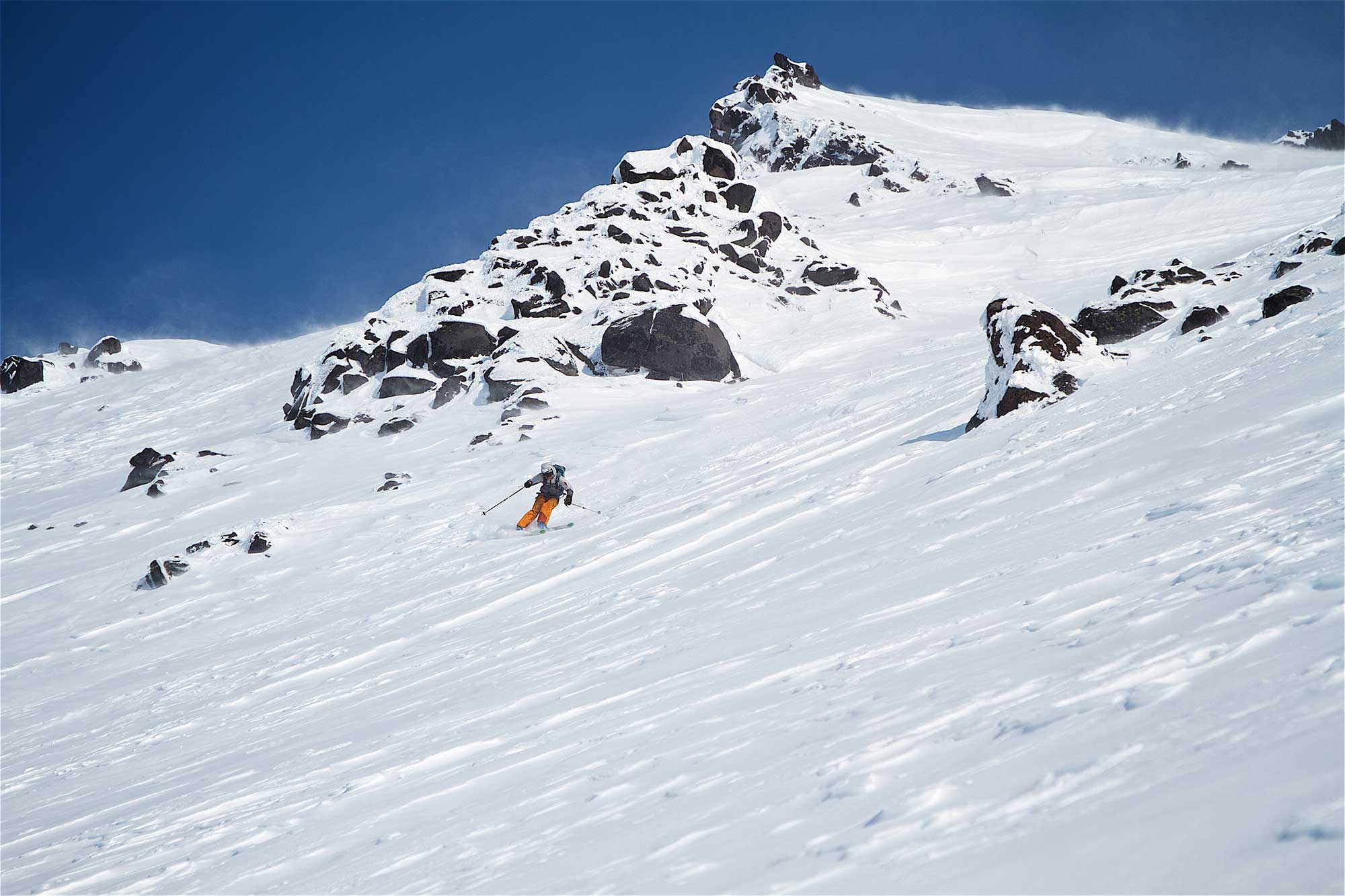
Andrey leads the way down Bakening´s flanks. Photo: Fojtik
Exploring Further
Storms rolled in, grey clouds swallowing the nearby peaks. Wind, snow, and low visibility kept us from the high alpine, but the smaller ridges near camp featured enough windlips, chutes and spines to pass the time. Tom negotiated some difficult snow on technical spine lines, Herder and Luke tossed backflips off windlips and tree stumps, and Andrey sought out more freeride-style lines with cliffs and playful natural hits.
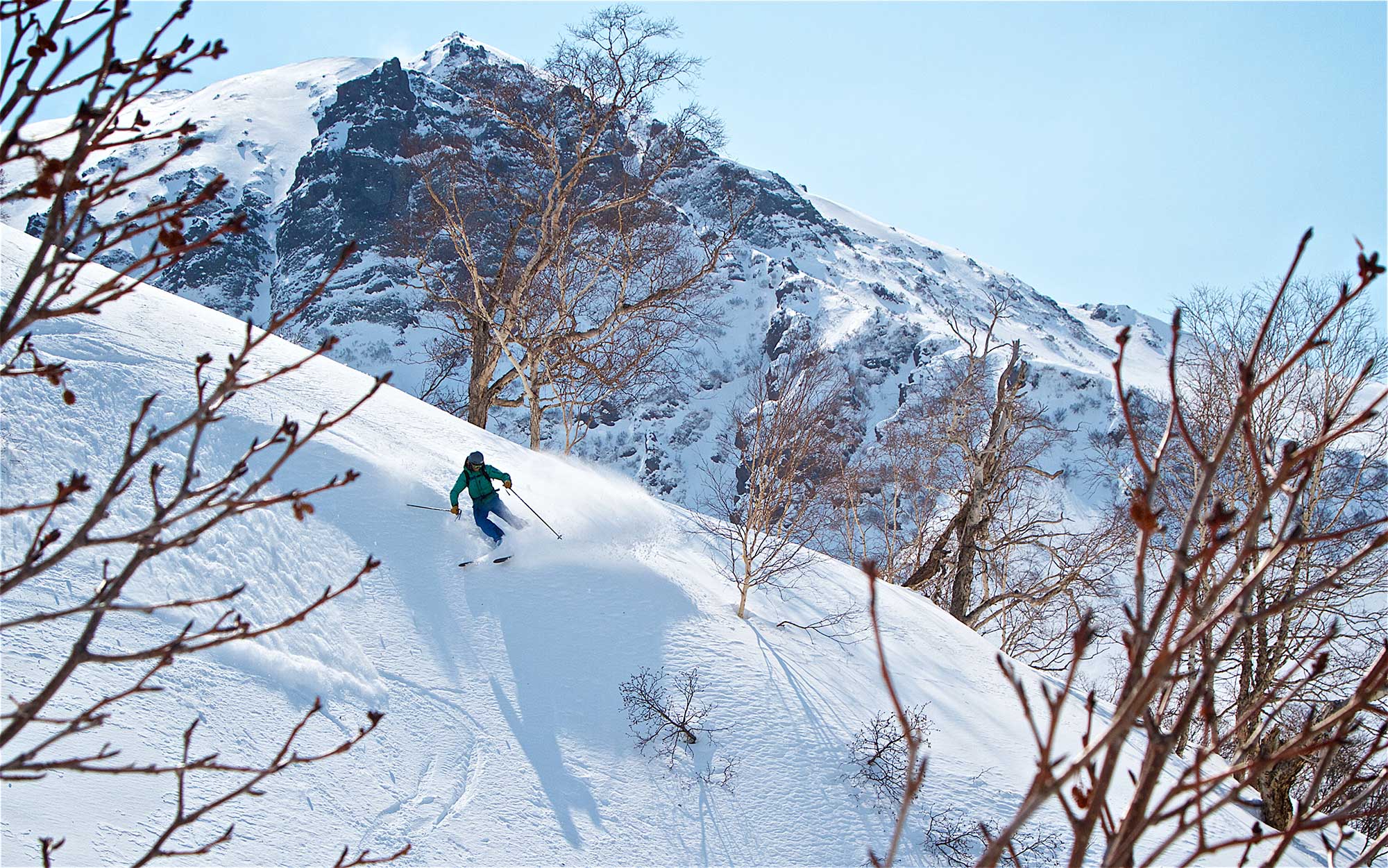
Drew Layman scores turns on a sheltered slope. Photo: Fojtik
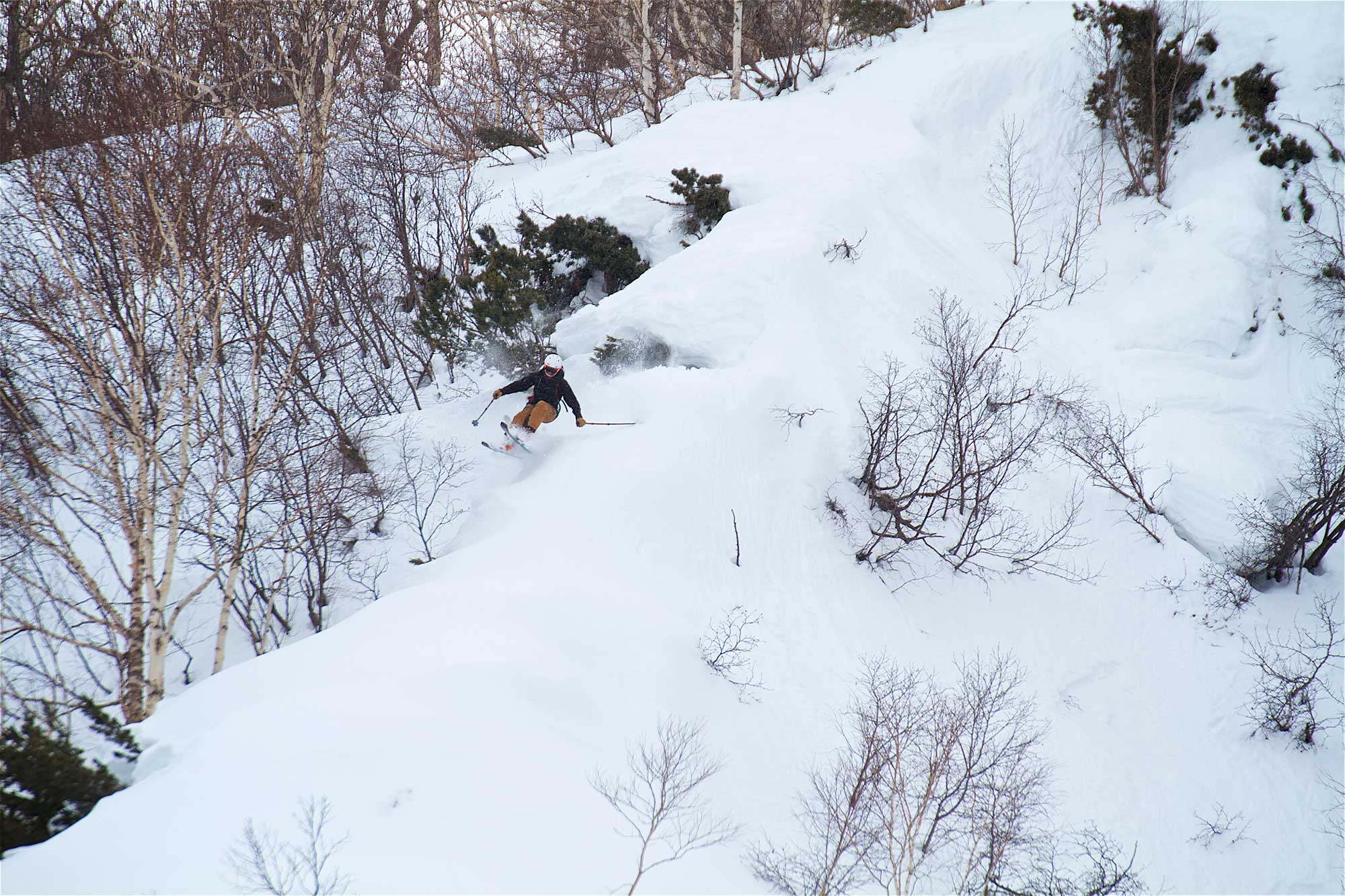
Let ‘er buck: Tom gets loose on a mini-spine in the trees just outside camp. Photo: Fojtik
Having exhausted our local playground of hills and features, we set out, ravenous for high-alpine lines, as soon as the storm broke. Our first target was “The Vertebrate,” two parallel couloirs on either side of a rock outcropping that resembled a spinal column. Andrey, Luke, and I climbed to the top, and found blasting winds on the ridge. The descent offered variable snow and delicate skiing, with a mix of bulletproof wind board near the top of the line and more forgiving snow further towards the base. Meanwhile, Herder and Elliot explored an area they dubbed “Patagonia” due to the prominent and bizarre rock pillars lining its peaks and flanks. We regrouped later and skinned together towards the “Honey Hole,” finding cold, soft, stable, wind-protected snow for an afternoon treat.
The following day Andrey, Layman, and I set out for an area called “Mini AK,” so named for its full-commitment lines protected by massive cornices and cliffs. We warmed up on a smaller couloir, then worked our way up to more serious descents. Elliot joined, and he and Layman tagged a beautiful north-facing couloir in pristine snow. Andrey and I took another option with a small cliff band to air off. We all met in the valley, and skinned back to the Honey Hole for another serving of late-afternoon powder.
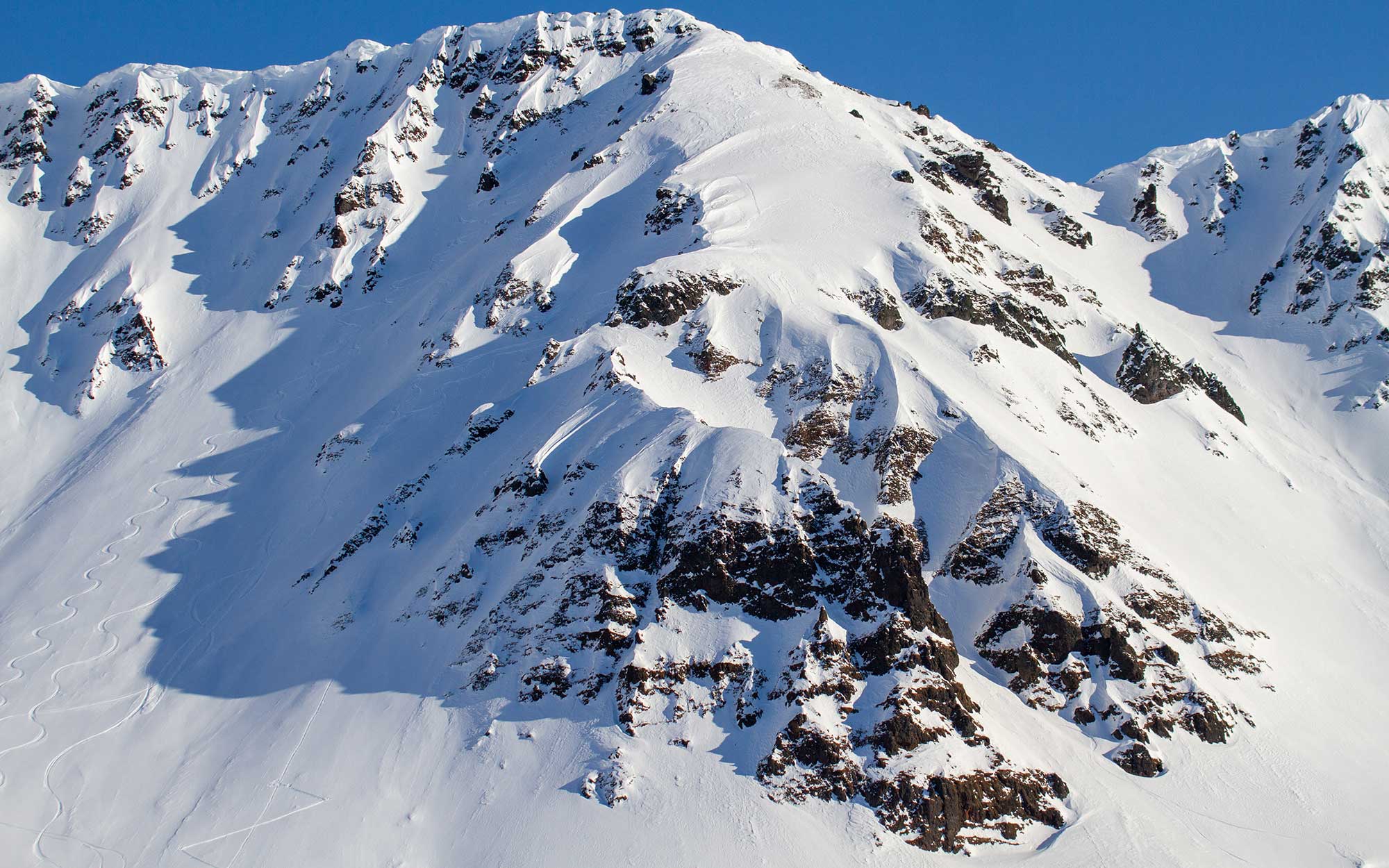
We named this zone Mini AK for its commitment-demanding lines guarded by cliffs and cornices. Only once, near the end of our time in the Bakening River Valley, did we feel it was safe enough to venture to bigger north-facing lines like these. Photo: Fojtik

Andrey finds the honey: First tracks in the Honey Hole, named for its consistent soft, stable snow and the golden hours of afternoon light while we lapped it. Photo: Fojtik
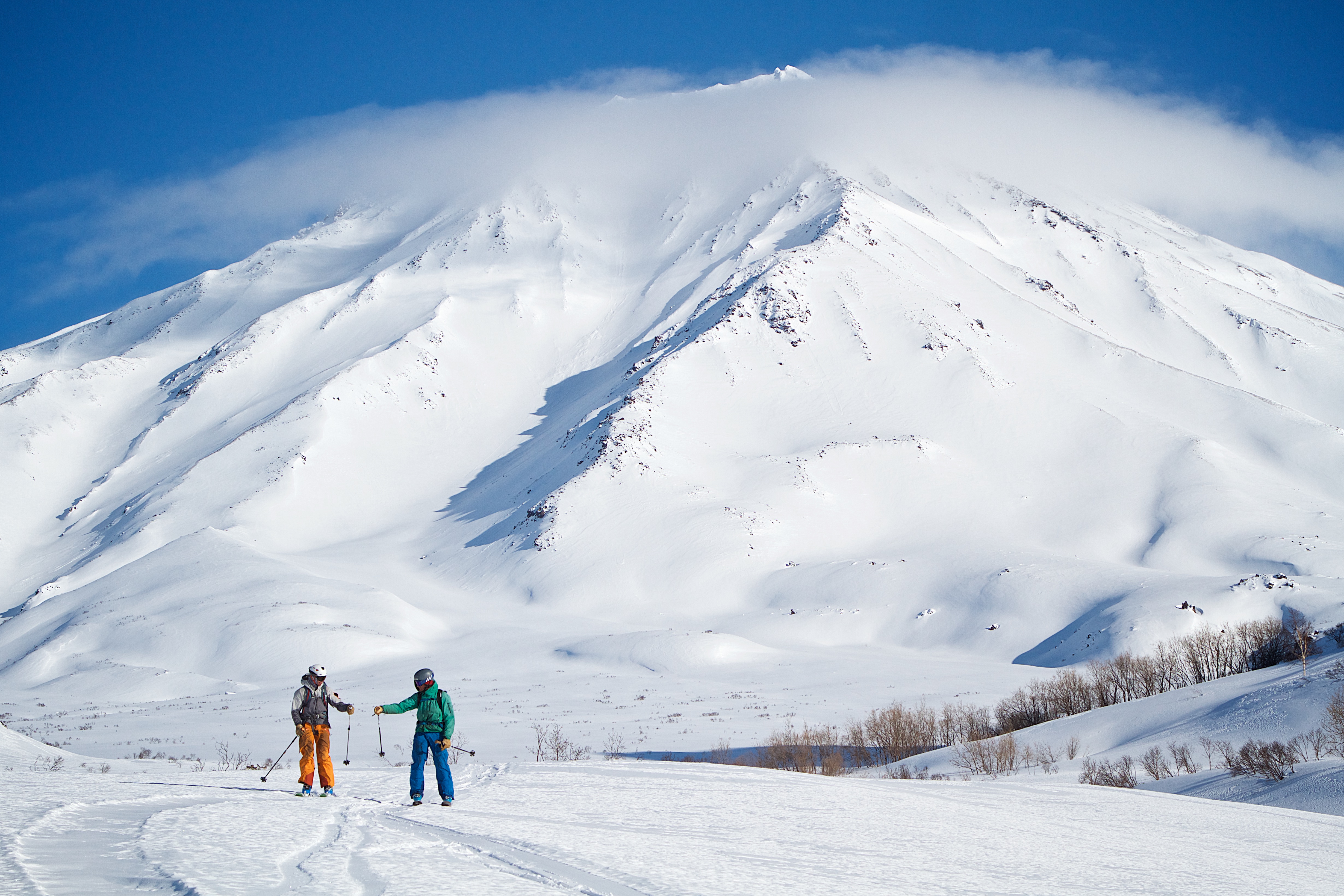
Another good day beneath Bakening´s watchful gaze. Photo: Fojtik
That evening, Andrey and I skinned up for a sunset lap on a south-facing slope just outside camp. The south-facing, low-elevation slopes were in a melt-freeze cycle, and we caught the snow as it was re-freezing, giving us some of the worst conditions of the entire trip. Despite the snow, this was one of my favorite runs. It capped off an incredible day in an incredible place with some incredible people. The last rays of light caught the spray of ice off Andrey’s skis, illuminating the pellets neon-orange against the cool-blue of the refrozen surface. Bakening, bathed in pink alpenglow, stood defiant against the growing shadows of the valley below.
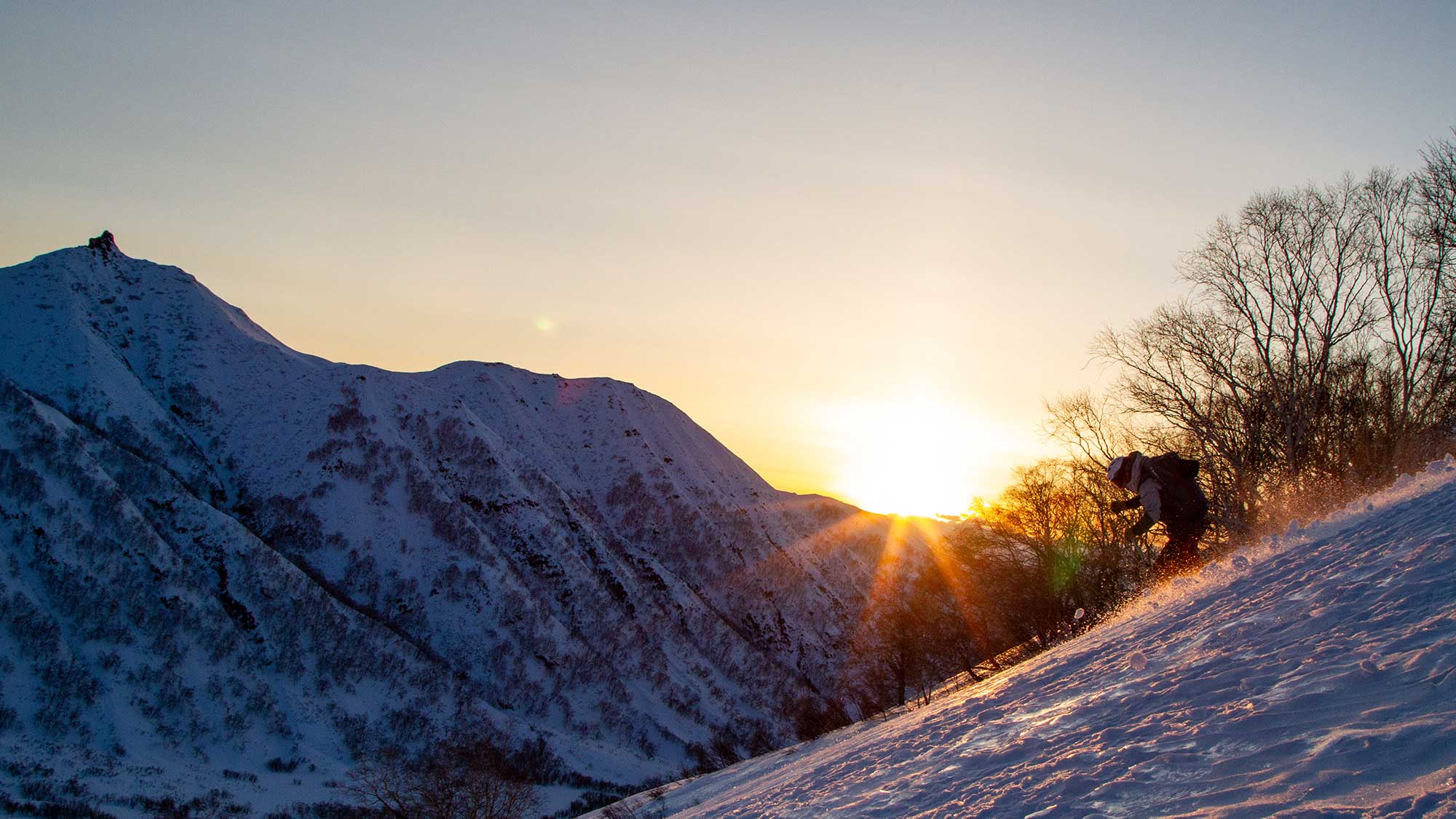
After a long day of skiing, we caught this south-facing slope as it refroze during sunset. It was some of the worst snow of the trip, but one of the most memorable runs. Photo: Fojtik
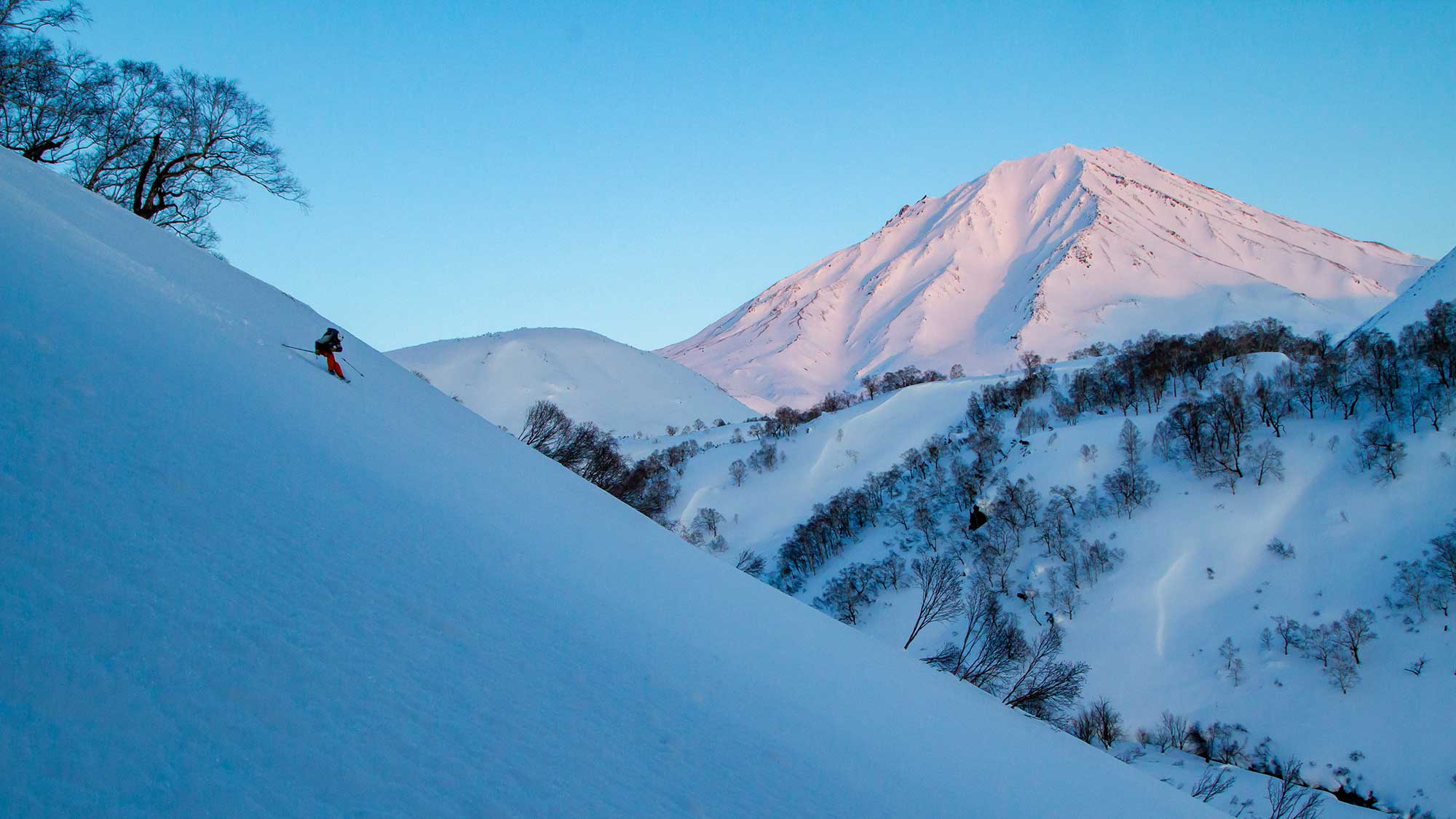
Andrey rips to the valley floor as Bakening catches the last glimpses of sunset. Photo: Fojtik
During our last days in the Bakening River Valley, Andrey, Layman, and I tried our luck on a massive couloir close to camp. only to be turned around before the peak, again due to wind. Herder set up a tree jib in camp, and we watched and took photos of his jibbing, while Tom sent and stuck a massive drop in variable snow nearby.
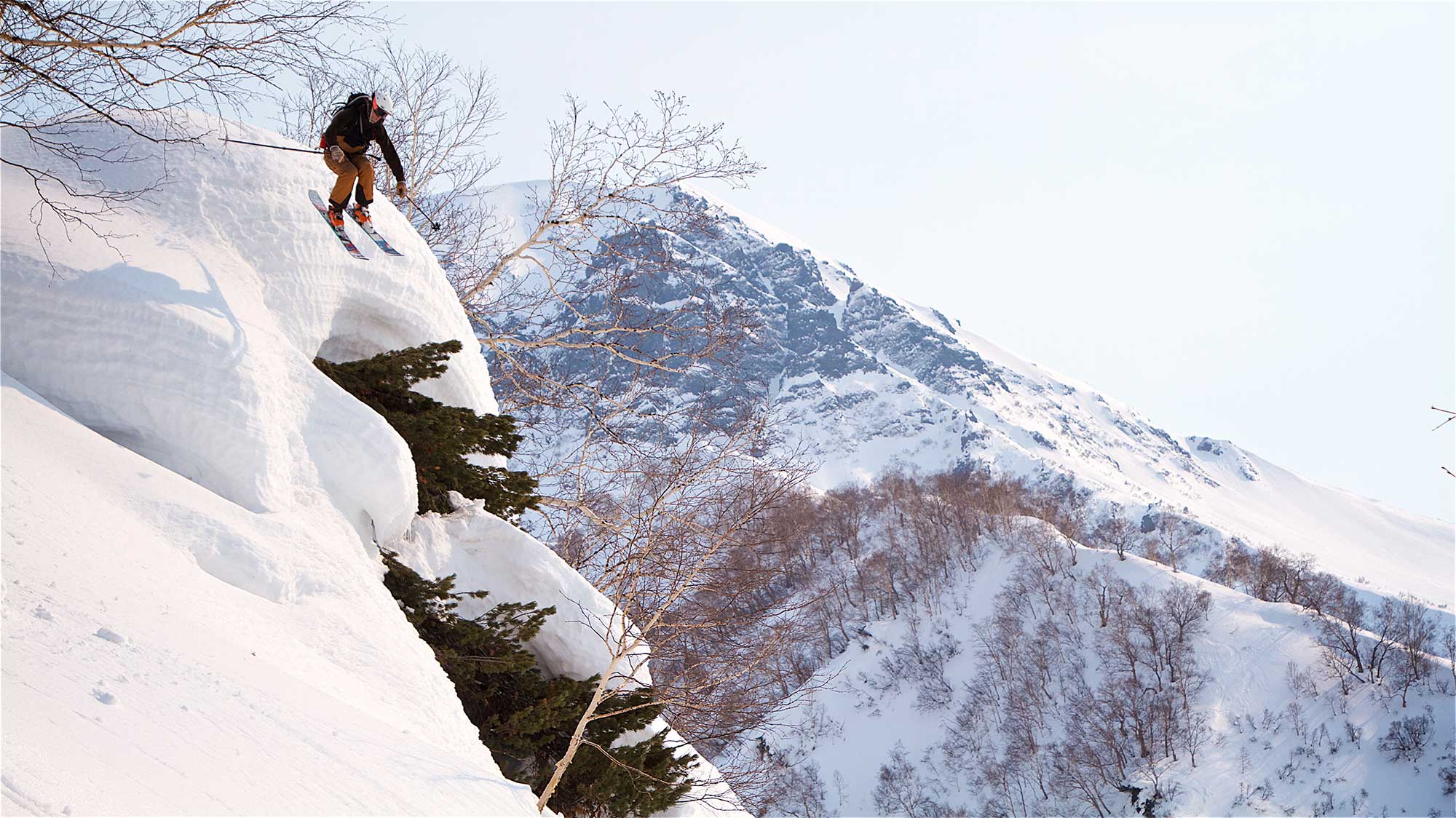
Tom sends a drop above camp. Photo: Fojtik
On the arranged day Alexey and Kyril returned with their sleds and towed us out of the valley. Back at the road, they loaded their sleds onto their trailer, hopped into their car, threw a U-turn, and headed back towards Petropavlovsk, leaving a pile of ski gear and seven confused Americans on the side of the road. Ivan, our fixer for the second part of our trip, would pick us up here.
We waited. Ivan didn’t show up.
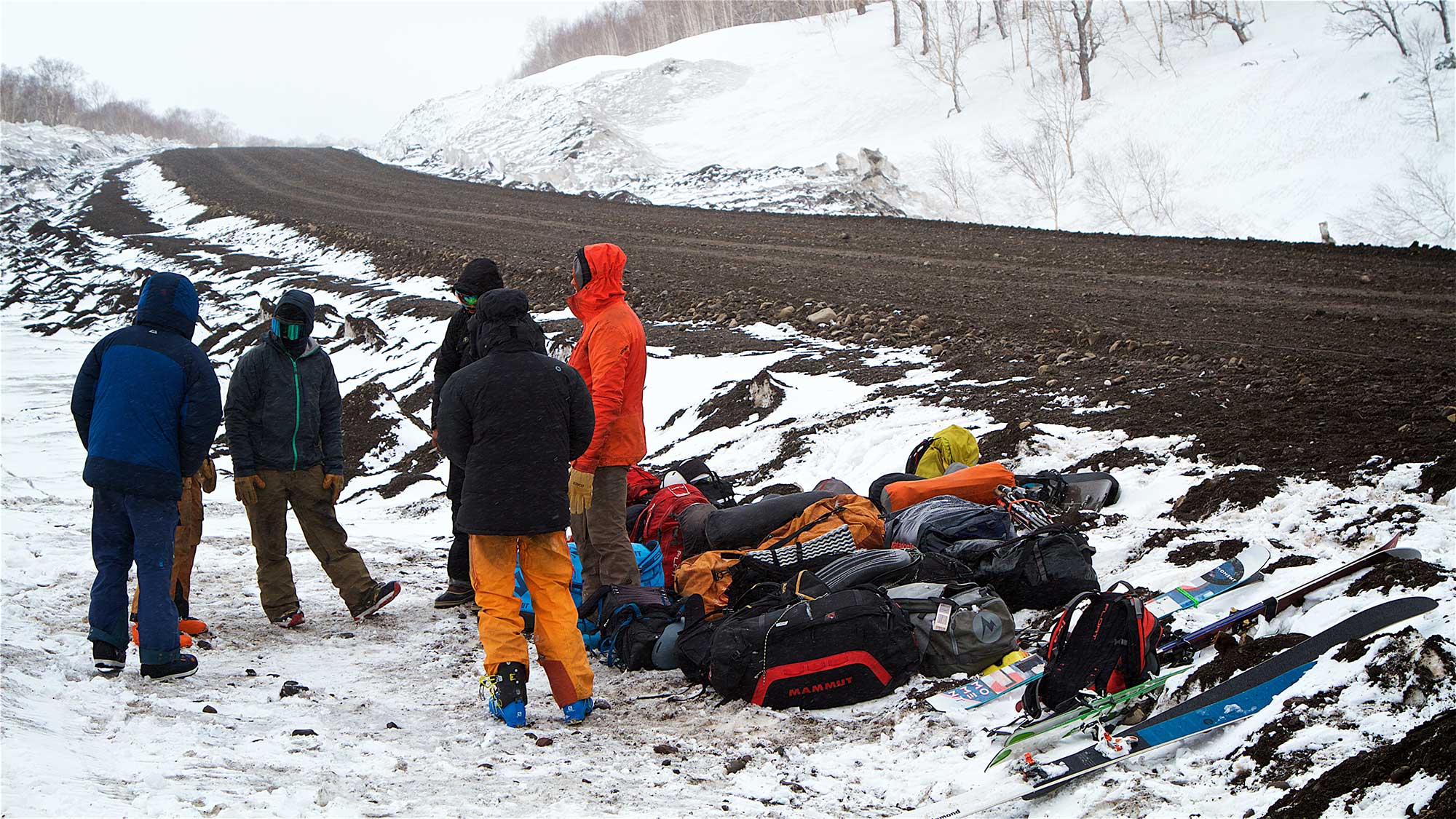
After Alexey and Kyril towed us out of the woods, they loaded their sleds onto thier truck and took off back to Petropavlosk, leaving us and our gear stranded on the side of Kamchatka’s only highway. Photo: Fojtik
Click here for Part 2 of the Burger Boyz' adventures in Kamchatka.
